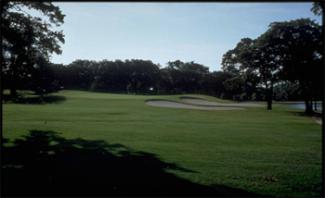Featured Golf News
Q. How Big Should A Green Be?
There are no set rules on green size or how it must be bunkered and, frankly, one of the joys of golf is that playing fields are all different! We size greens mostly intuitively, and to fit the ground (a large green on a small site is difficult) involves doses of common sense and experience. However, I do follow some general guidelines based on both play and maintenance factors.

Is this green the
I believe that "form follows function" (unlike federal workers, who believe forms follow other forms) and typically relate green size to approach-shot length. Most golf course architects since the Golden Age have agreed with the general idea of "long shot, big green; short shot, small green," based on the notion that a 200-yard shot 2 degrees off-line misses the mark twice as far as a similar shot from 100 yards.
The USGA obtained voluminous field data when researching its Slope system, which confirmed this principle. They suggest the "average" green be large enough for two-thirds of golfers to hold the putting surface with approach shots for the most enjoyable golf experience. That, with some shameless rounding, translates to these approximate "rules of thumb":
• For Tour-level players - 10 percent width and depth of approach shot length
• For low handicappers - 12.5 percent width and 15 percent depth of approach-shot length
• For high handicappers - 15 percent width and 20 percent depth of approach-shot length.
Every course will vary, of course, with its membership/clientele, but my preference as a practical matter is to size greens for average golfers. Sometimes, one seemingly odd (to some) exception is greens on very long par-4 holes, where we expect shorter hitters to come up short in two shots, and thus feel free to "downsize" the green to challenge the best players.
However, sizing every green strictly to this formula isn't necessary or desirable. If every green was sized accordingly, each would play with the same relative difficulty, which would be boring. A few greens - but not too many if you want to avoid undue difficulty - should be somewhat smaller or harder than the approach distance suggests, and a few greens somewhat larger for an easier approach. Different green sizes can also compensate for extraordinarily difficult or easy tee shots, or provide variety among similar-length approaches.
Sizing greens strictly to this formula is difficult, because determining the exact approach-shot length is impossible given the wide variety of players and tee-shot lengths, and the percentage (about 23 percent on average) of miss-hit tee shots, etc.
With multiple tees, do all skill levels of players reach the approximate landing zone? If so, do you size the green at 12.5 percent width and 15 percent depth for low handicappers or bigger for high handicappers? Do you allow for the longest or shortest hitters who find the fairway landing zone? On a public course, do you accommodate the maximum probable approach-shot length (about 180 yards for average players) to allow for bad tee shots?
Green sizing would be easier if multiple tee setups put shorter hitters proportionately closer to the green than low handicappers; i.e., 100 yards out vs. 150 yards. Then, the green would be 15 yards wide in both cases, and my tendency would be to add depth to accommodate average players, knowing that better players still gain advantage through accuracy via shorter putts.
In reality, each hole requires some analysis to get it as much right as possible and a determination as to whose golf game should be favored at the expense of others. While I can offer guidelines, as the old saying goes, "Your results might vary."
Jeffrey D. Brauer began his career as an apprentice in the Chicago area in 1977. His first project was Kemper Lakes, which shortly after hosted the 1989 PGA Championship. He formed GolfScapes in Arlington, Texas, in 1984. In the last 29 years he has designed and consulted on a wide spectrum of projects, ranging from partial renovations to international resorts. His recent work includes teaming with the design team of Pascuzzo and Pate on a remodel of the world-famous La Costa Resort & Spa in California, and renovations at Superior National Golf Course in Lutsen, Minn., and Mesquite Municipal Golf Course in Mesquite, Texas.
He has been a member of the American Society of Golf Course Architects since 1981, serving as President during its 50th Anniversary year in 1995-96. Jeff still studies the classic works - both old and new, and has played more than 75 of the best courses in the world.
Jeff gives many presentations and is a regular architecture columnist for many publications and websites, including Golf Course Industry and Cybergolf.com. He has also been a strong advocate for the "Tee it Forward" campaign and strives to make his courses fit the description of "fun to play every day."
Jeff's work has been spotlighted in most of the world's major golf magazines. Golf World ranked him as one of the top-20 golf course architects and Golf Inc. ranked him as the world's fourth-best value in golf architecture in 2010. Jeff's portfolio and reputation keep him at the forefront of desired designers for new courses, reconstruction and renovation projects.
For more about Jeff, visit http://www.jeffreydbrauer.com/sites/courses/layout.asp?id=859&page=48451.
Story Options
 |
Print this Story |
